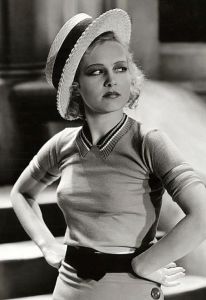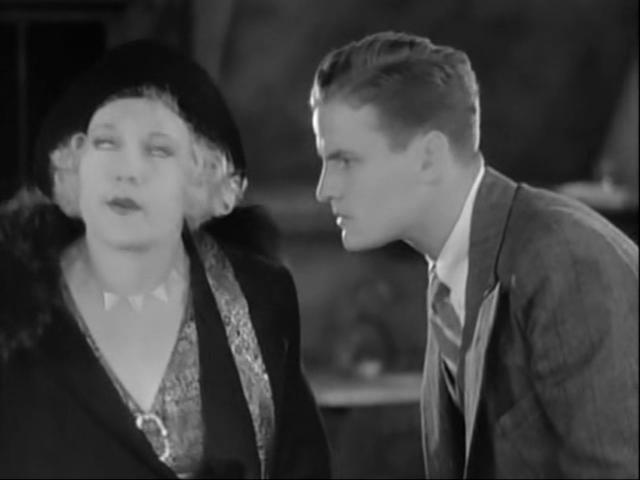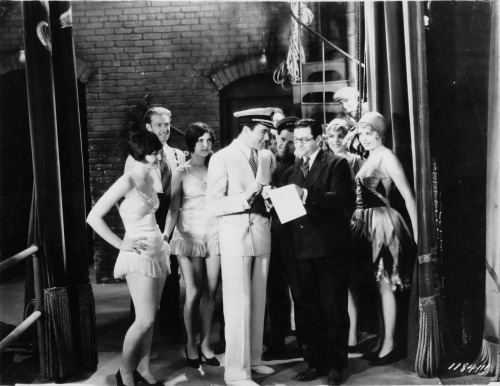So, we still haven’t finished with CLOSE HARMONY, I’m afraid. The picture may be lost but I am listening to the soundtrack and relaying to you the mental images it provokes, so that this vanished early talkie can live, breathe and jump again.
Now read on…

This section opens with a loooong silence, broken occasionally by coughing or shuffling noises. It reminds me of the remix of the John Lennon track Two Minutes Silence. The guy who did a cover version had to pay royalties to Lennon for the use of the complete silence, but his “remix” on the B-side was ruled to be a completely new composition because he’d added a few little coughs.
I’m trying to get my imagination going to fill in the picture for you here but I don’t have a lot to go on. Acoustically, I’d say it’s an interior. So we’re in a room somewhere, possibly with Charles “Buddy” Rogers shuffling his feet and nursing a slight bronchial condition. Then, dialogue breaks out — we now know we’re dealing with Buddy and Nancy Carroll, but the visual aspect remains mysterious. They could be disembodied spirits floating in an ethereal void. Maybe everyone was dead all along?
Now somebody’s singing scales. Jack Oakie? Buddy’s rival combo seem to be falling out, and this seems to be the result of offscreen activities by Nancy, setting them against each other. I say “offscreen,” but everything in this movie is offscreen. I guess I should say “off-mic”.
Now a brief convo between Oakie and the fifty-foot maid, in which we learn that Nancy has stood him up. This bombshell is followed by another pensive silence, during which to be honest anything might be happening. Oakie might be strangling the fifty-foot woman in a fit of rage, or vice versa, or the scene might have ended and a new one begun in at a deserted dog race, a beached canoe or a bottling plant during a power failure. After some seconds, the aural quality of the nothing that’s happening changes, and we perceive what might be a heavy rainfall.

John Cromwell brought to you by the miracle of photography
Cutting through the crackling spatter trills a female voice — impossible to figure from the cast list who she is, but she strikes up a chat with a glum Buddy. He thinks Nancy has jilted him because she hasn’t let him in one her plan to sow discord amid the rival band by flirting with each member in turn. WHY she hasn’t simply explained this is mysterious, unless it’s because the plan is so sleazy. Anyhow, Buddy now goes off with this other girl — at 45 minutes in, the plot is finally starting to thicken, to a nice stodgy Charles “Buddy” Rogers consistency.
Sudden loud jazz! We’re at the party where all the rival band are waiting for Nancy. “Wait? I’ll grow a beard!” remarks one. The music stops and what we take to be thunderous applause breaks out, though it sounds like an audience of sea lions. A more gentle tune begins — we’ve heard it before, it’s “All A-Twitter,” the favourite tune of America’s new president.
Buddy’s date is now mentioned by name, so we can deduce that the actor is Greta Granstedt in one of her few roles that actually has a name. The character she made a habit of playing, according to the IMDb, was “minor role,” occasionally branching out into “extra” or “blonde.” And she kept this up for 29 years. Also at the IMDb, a Jim Kalafus supplies some exciting biographical detail for Greta ~
“Greta Granstedt was the San Francisco room-mate of explorer Bessie Hyde, who vanished, under mysterious circumstances, along with her husband Glen, while attempting to become the first couple to navigate the length of the Grand Canyon solo. Miss Granstedt’s parents were aboard the liner San Juan, which sailed between San Francisco and Los Angeles, when she sank less than three minutes after colliding with a tanker. Mr. Granstedt survived, his wife did not. According to the newspapers, they were en route to L.A. to visit with their actress daughter when they were caught up in the August 1929 disaster.”
So that disaster happened the very year CLOSE HARMONY was released. We don’t know if Greta is smiling through her tears as she plays this very scene.

Greta in something else.
“Ain’t you glad you got me here all alone?” asks Oakie, suddenly, so we’re somewhere else, but not far away — we can still hear music. So I’m guessing he and Nancy have passed noiselessly through the French windows and are maybe out on some rooftop under the moonlight. Moonlight itself makes no sound, unless it sounds like Jack Oakie. I guess that’s possible. Just as, in colour movies, moonlight is portrayed as being blue, when in fact it is colourless and so dim as to render everything else colourless too, perhaps a similar convention existed in early talkies: whenever there’s moonlight, dub in some dialogue from Jack Oakie. So my impression that Oakie is in this scene in person may be a misapprehension. Perhaps Nancy is talking to the moon.
“Gee, it must be great to play on Broadway,” says Nancy, which doesn’t clear things up any. I mean, you could equally well say that to the moon as you could to Jack Oakie. If anything, the moon seems a more plausible listener. Nancy now gets her interlocutor to bad-mouth the character played by Richard “Skeets” Gallagher, Oakie’s musical partner. So I’m starting to think he’s not the moon. I don’t see why the moon would have a strong opinion on Skeets. I’m also visualising Skeets listening in on this, his face aflame, ears incandescent. I think such a thing was well within his range as an actor, and if not, well, *I’m* the one visualising this picture now, so I can easily render him capable of furious jealousy worthy of Othello. Though I don’t know if he would find it more natural to project such emotion at jack Oakie or at the moon. It may be there’s no real difference.
To be concluded…











